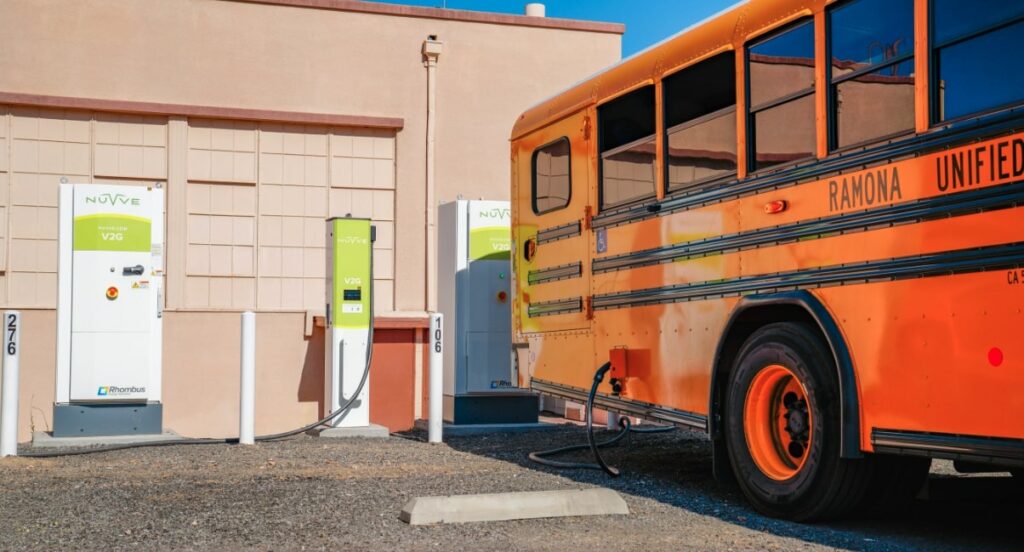
A trio of projects using electric vehicle (EV) batteries and charging infrastructure to support the grid in California have been announced this week.
The first, in Oakland, will see stored energy from electric buses provide backup power to the West Oakland Branch of the Oakland Public Library, to power its recently-upgraded HVAC and air filtration system, providing clean air and electricity to create a public shelter during emergencies and outages.
Enjoy 12 months of exclusive analysis
- Regular insight and analysis of the industry’s biggest developments
- In-depth interviews with the industry’s leading figures
- Annual digital subscription to the PV Tech Power journal
- Discounts on Solar Media’s portfolio of events, in-person and virtual
Majority-funded by the California Energy Commission (CEC), the US$3.6 million project aims to demonstrate the value of bidirectional EV charging to create a ‘vehicle-to-building (V2B) resilience hub’, the first of its kind.
Partners in the project are the Center for Transportation and the Environment (CTE), The Mobility House, AC Transit, New Flyer, Schneider Electric, the City of Oakland and WOEIP (West Oakland Environmental Indicators Project).
Each electric bus will contribute six hours of backup power to the critical loads at the library while hydrogen fuel cell-electric buses will provide up to 11 continuous hours of backup power.
“Powering emergency shelters with islanded energy supply is an innovative feat we are honored to help facilitate,” said Jana Gerber, president of Microgrids North America at Schneider Electric, a company specialising in digital automation and energy management.
Infrastructure for the project is expected to be installed by the middle of 2023, and demonstration, analysis, evaluation, and knowledge transfer for the pilot programme will last two years thereafter.
Meanwhile in San Diego, eight new electric buses have been unveiled by vehicle-to-grid (V2G) company Nuvve, bus manufacturer Blue Bird Corporation and the Ramona Unified School District. They are powered by Nuvve’s DC fast chargers and its GIVe V2G energy aggregation platform.
The vehicles are qualified to generate revenues for the school district through investor-owned utility (IOU) SDG&E’s Emergency Load Reduction Program (ELRP), by selling energy stored in the batteries back to the grid during times of high grid stress or emergencies. ELRP was launched by the California Public Utilities Commission in October 2021 to allow consumers to reduce usage to help avoid grid outages during peak periods.
The School District will be able to use the buses to receive $2 per kWh as part of the ELRP, equating to up to US$7,200 per bus per year.
“When a V2G interconnection occurs, the bus, charger and grid are essentially talking to each other,” said Gregory Poilasne, founder and CEO of Nuvve. “This communication through our GIVe platform is essential: it monitors the amount of energy being sent to the grid, while ensuring there’s enough energy necessary for drivers to complete their routes the next day.”
Blue Bird and Nuvve’s cooperation started in 2020 and now all of the former’s Type V and Type D electric buses come standard with Nuvve’s V2G integration capabilities. School districts can use Nuvve’s V2G platform to charge the buses when rates are low and sell energy back to the grid when rates are higher, to help offset the upfront costs of the charging infrastructure.
As readers of Energy-Storage.news‘ coverage of developments in the V2G space will know, many projects in the space are using school buses. Larger batteries and more predictable usage schedules make them fertile ground for the technology, while many challenges remain in the consumer EV space.
While the previous two announcements show examples of electric vehicle batteries providing power to the grid, battery-integrated EV charging infrastructure can do the same.
Distributed energy resource (DER) platform company Voltus this week announced it is working with FreeWire Technologies, which manufactures such battery-integrated infrastructure, to provide flexible battery charing load to grids throughout the US.
The initial phase of the collaboration will also be in California. Another IOU, PG&E, will be able to dispatch FreeWire’s infrastructure to provide critical support to grid operator CAISO (California Independent System Operator) to mitigate blackout risk.
“Our partnership with Voltus enables us to provide essential services to the grid, while safeguarding the charging experience for the EV driver,” said Sudhansh Neravetla, director of energy services, FreeWire Technologies.
“By connecting FreeWire’s charging station to electricity markets, Voltus helps to realize the full financial and sustainability value of EVs and charging stations,” added Dana Guernsey, Voltus chief product officer and co-founder.
California aims to deploy 250,000 public and shared private EV chargers by 2025. Forecasts for 2030 demand indicate around 1.2 million chargers will be needed for light-duty (i.e. consumer) vehicles and 157,000 chargers needed for medium- and heavy-duty vehicles.






